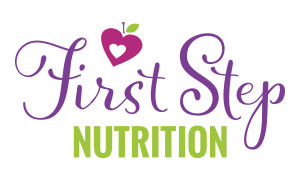
5 Reasons to have family meals, and how to make them happen
When you think of the family table, we all have the image of a happy family, eating and laughing together. Which may make you LOL it’s so far from your dinnertime reality right now. I have 3 kids, so I get it (and our meals rarely look like this photo shoot pic!).
You might have a hard time just getting food on the table to start. Or avoiding fights, battles and tears because your kids won’t eat. Or even just getting everyone together at the table, schedule-wise may be a challenge!
Today I’ll touch a bit on how to end the dinnertime battles and provide some structure and routine. But I’m mostly going to chat about WHY it’s worth this effort to get your family to the dinner table together.
First of all, to define “family meals,” this includes eating together at least 3-5 times per week. At least one caregiver with the kids. If one parent is not present or you are a single parent, you STILL get these benefits by sitting down with your kids yourself.
1) The Stats on family meals:
Eating together (and hence conversing) as a family improves language development in toddlers and preschoolers.
Adolescents who have regular family meals not only:
– have a more nutritious diet, but
– get better grades in school,
– have healthier relationships and
– are less likely to be involved in risky activities like drugs, smoking and alcohol use.
Family meals are more important to an older child’s self-esteem and confidence than income levels, after-school activities, family structure (one parent or two), or religion! Wow. If you could provide this to your kids, would you? Of course.
2) Family meals develop your child’s relationship with food
This is more about the dynamics of the family meal and ending the arguments about eating dinner or veggies. Because nobody has an appetite when they come to the table, knowing it’s going to be a fight. Our stress hormones are high, and physiologically, we don’t feel like eating.
A healthy relationship with food will prevent some picky eating, struggles with emotional eating, weight and eating disorders down the road.
A child who comes to the table without pressure to eat will be more likely to have a healthy relationship with food. On the other hand, a child who comes to the table and gets force-fed, pressured, bribed or threatened to eat (regardless if they are hungry) will have more struggles with eating.
This is why it’s so important to take the focus OFF of the food and how much your children have eaten. Kids know their appetite best, and it’s a great skill to keep. Yes, this is a HUGE leap and mind shift for many parents. If you want more support with this, email me, and I’ll share options for how we can work together.
3) Family meals can develop your child’s taste for different foods
Kids will eventually learn to eat the types of foods that they are repeatedly exposed to. So if they are always fed ‘kid-food’ like chicken fingers and KD, then that’s what they will like!
Some kids do really have sensory or physical issues that prevent them from eating certain foods. But most others are fed what they want because their parents are afraid they will starve or wake up hungry in the middle of the night. I’m permitting you here to stop being the short-order cook and make one meal for the whole family!
Caveat: I’m not against take-out night or saying the food always has to be homemade or fancy! Simple is fine. Along with a side of veggies – frozen or from a bag is ok 😉
4) Family meals are a chance to connect
Many of the stats I talked about earlier aren’t to do with the food. It’s to do with the family unit and connecting. And the dinner table is one of the best places to do this.
Around the table, kids can learn how conversation works. One person talking and the others listening. And taking turns. Make the conversation about something other than the food – like what happened during everyone’s day.
One conversation starter we love to do is to go around and share our “highs and lows” from the day at our dinner table.
5) Family meals create memories & traditions
I think many of our own childhood memories are probably from the dinner table. Especially for holidays. It’s an awesome place to create memories and traditions that your child may carry forward to their kids. Even if it’s something simple like taco Tuesday, pizza Friday or kid’s- make- dinner- Saturdays.
I hope that has convinced you to either have more regular family meals. Or if your family meals are full of food fights, try and make them more peaceful and take the focus off of the food.
So that’s all great – we want to have family meals. But HOW do you make this happen with picky eaters, multiple kid activities and all of that cooking?!
Tips to make family dinners easier
1) It doesn’t have to be dinner
You can have breakfast or lunch together if that fits your schedule best. As long as you can manage to sit down with your kiddos three times a week, they will benefit.
2) It doesn’t have to be at home or around the kitchen table
If you’re off to watch a kid’s baseball game, you can bring sandwiches or food in thermoses.
Throw down a picnic blanket any summer night of the week to save the indoor mess!
3) Don’t make meals a fight
Especially if you have a picky eater. Forcing them to try the vegetable or eat three bites just stresses everyone out.
We’re trying to keep the dinner table as peaceful as possible for everyone! If this is a struggle, watch my free training: “How to teach kids to try new foods without struggles at dinnertime.”
4) Get kids involved in cooking, setting the table and tidying up
Kids take great pride in cooking up a dish for the family to try. Especially if your kids are older, they can have a night of the week to cook. This also provides them with a very important skill when they’re off on their own.
5) Serve family-style meals
Family-style meals are when all of the foods offered for a meal are placed in the centre of the table. Everyone gets to choose what to put on their own plate and how much.
This is in contrast to serving your child’s food already plated. Which almost immediately starts the: “yuck, I don’t like that.” Allowing your child to choose what to put on their plate, it results in less complaining.
6) Have a plan for the food
Having at least a rough idea of what you’re having for dinner every night is a sanity saver. And not only sanity but time and money too. I know it’s hard to muster up the energy and time to throw dinner together, and sometimes it’s just easier to call hubby and ask him to grab a pizza.
This is fine and still counts as a family meal! But a few minutes upfront per week to plan your meals is highly worth the time and effort.
HERE’S WHY MEAL PLANNING WILL SAVE YOUR SANITY:
1) Meal planning saves TIME.
We all want more time. And often struggle to find the time to get organized and meal plan regularly. However, the catch 22 is that having a meal plan will save you significant time during the week!
- Think of the time it takes to dig through the pantry/freezer wondering what to cook every day. You can do this just once a week instead of daily
- A lot of time can be wasted trying to find that recipe you attempted once and everyone loved. But you have no idea what website it came from!
- And without a plan, you often end up at the grocery store more often than needed. Sometimes daily – for those 1 or 2 missing ingredients you need to make that recipe you found on Pinterest this morning. Yes yes, the grocery store great learning experience for your kids. But personally, I find shopping with my kids a struggle and would rather do it once per week than a once per day!
2) Meal Planning saves MONEY
- Decreases food waste. Did you know the average Canadian family throws out about $1500 worth of food per year? That’s crazy! But if you buy random food and don’t have a plan for it, the produce goes limp and you eventually toss it in the bin or compost.
- Less processed food purchases: it’s easiest to grab takeout. Or keep a stock of processed foods like pepperoni pizza for those days that you don’t have anything planned. And these purchases often cost more than many home-cooked meals. Especially the restaurants and takeout.
- Less trips to the grocery store: I mentioned this in the saving time section, but it also fits with saving money. You might go in with the idea to buy 2 ingredients, but that never happens Especially if you have your kids along and they blow a fit about getting a bag of gold fish crackers ?
3) Meal Planning allows for more balanced nutrition
- You can Plan a whole week that’s balanced. i.e. include a fish meal, vegetarian etc.
- Again, less processed microwave dinners, fast food and restaurants. In general, these are higher in sodium and preservatives and lower in fibre, vitamins, minerals and antioxidants than most meals you’d cook at home.
4) Meal Planning save stress
I’m sure we all have enough stress in our lives from work to relationships and kids. And if you’re the mom, you likely have the main mental load for organizing your family on your shoulders: planning repairs, dentist trips, kid activities, clothing them., etc., etc. So anywhere we can simplify the amount of mental energy, the better.
- If you don’t know what’s for dinner, how often do you think “What’s for dinner” during the day? Once? Twice? Dozens? It’s more mentally taxing than you might think.
- And then feeling like you’re not providing your kids healthy food; or teaching them cooking skills; or being the role model you want to be. That can be stressful too.
- Not to mention the lack of planning leading to more trips to the store. And if you’re taking your kids along, that likely means more stress (unless mine are the only ones begging for certain foods, running around or throwing tantrums!).
5) Meal Planning Teaches your Kids
- Your kids get used to eating homemade food, it becomes normal and tasty for them. Rather than acquiring the taste only for KD and McDs.
- Getting involved in the choosing of recipes and cooking are invaluable skills that they need when they go off to college. And home ec isn’t taught in stores anymore so it’s up to us!
I hope I’ve convinced you all that meal planning is definitely worth the effort. It will save you time, money, stress, improve your nutrition and set a healthy food foundation for your kids.
Want some help getting started? Sign up here for my free 7-day family meal plan.
Jennifer House is a Registered Dietitian, author & mom of 3. From Baby-led weaning to picky eating and meal planning, she helps you to make feeding your family easier
Founder of First Step Nutrition | Registered Dietitian Nutritionist
Jen believes raising happy, well-nourished eaters who have a healthy relationship with food doesn't have to be a battle! She is an author and speaker with 18 years of experience specializing in family nutrition and helps parents teach their kids to try new foods without yelling, tricking, or bribing.






Sorry, the comment form is closed at this time.